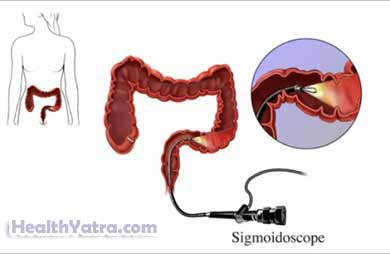Definition
A flexible sigmoidoscopy is a visual exam of the rectum and lower portion of the colon (large intestine). The exam is done with a tool called a flexible sigmoidoscope. The sigmoidoscope is a flexible tube with a tiny camera on the end. This instrument allows the doctor to see inside your rectum and colon.

Reasons for Procedure
It is used to examine and diagnose problems inside your rectum and lower colon. The procedure is most often done to:
- Obtain tissue samples for testing
- Identify the cause of rectal bleeding, diarrhea, constipation, lower abdominal pain, or inflammation
- Detect the presence of or remove polyps (small growths than can turn cancerous)
- Monitor response to treatment if you have inflammatory bowel disease
- Screen for colorectal cancer
Possible Complications
Complications are rare. But no procedure is completely free of risk. If you are planning to have a sigmoidoscopy, your doctor will review a list of possible complications, which may include:
- Bleeding
- Perforation or puncture of the bowel wall
Factors that may increase the risk of complications include:
- Pre-existing heart or kidney condition
- Treatment with certain medicines, including aspirin and other drugs with anticoagulant or blood-thinning properties
- Prior abdominal surgery or radiation treatments
What to Expect
Prior to Procedure
Before the procedure, your doctor will:
- Ask you about your health history and do a physical exam (including a rectal exam)
- Do an occult blood test to check for hidden blood in your stool
- Talk to you about your medicines. You may be asked to stop taking some medicines up to one week before the procedure, such as:
- Aspirin and other nonsteroidal anti-inflammatory drugs (such as, ibuprofen, naproxen)
- Blood-thinning drugs, such as warfarin (Coumadin)
- Anti-platelet drugs, such as clopidogrel (Plavix)
- Iron supplements
Your lower intestine must be completely cleaned out before the procedure. Any stool left in the intestine will block the view. This preparation may start several days before the procedure. Follow your doctor’s instructions, which may include:
- Drinking a special solution to stimulate bowel movements
- Taking laxatives
- Using an enema
Your doctor may also instruct you to follow a clear-liquid diet.
Anesthesia
Your doctor may sedate you to decrease discomfort.
Description of the Procedure
You will be positioned either on your left side with knees bent and drawn up toward your chest, on your back with your feet in stirrups, or on a special table. Try to relax. Breathe slowly and deeply. The doctor will do a rectal exam with his finger. Then, the lubricated sigmoidoscope will be slowly inserted into your rectum. The scope is about the same thickness as a human finger. The scope will be passed through the rectum and into the colon. It will inject air into the colon to widen the passage and make it easier to see the walls. As the scope moves along, it will provide a video of the colon lining. The doctor will watch the video images to look for any abnormalities. A tissue sample and/or polyps may be removed.
How Long Will It Take?
The procedure typically lasts about 20-30 minutes.
Will It Hurt?
Most people report some discomfort when the instrument is inserted. You may feel cramping, muscle spasms, or lower abdominal pain during the procedure. You may also feel the urge to move your bowels.
After the procedure, gas pains and cramping are common. These pains should go away with the passing of gas.
Postoperative Care
If any tissue was removed, it will be sent to a lab to be examined. It may take 1-2 weeks for results. A small amount of bleeding may occur during the first few days after the procedure.
The doctor will usually give an initial report after the scope is removed. Other tests may be recommended.
Be sure to follow your doctor’s instructions, which may include:
- Taking your medicines again (if you had to stop taking them)
- Returning to your normal diet
Call Your Doctor
After arriving home, contact your doctor if any of the following occur:
- Bleeding from your rectum
- Black, tarry stools
- Severe abdominal pain
- Hard, swollen abdomen
- Signs of infection, including fever or chills
- Nausea and vomiting
- Inability to pass gas or stool
- Chest pain or trouble breathing
In case of an emergency, call for medical help right away.
